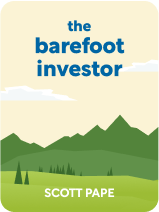

This article is an excerpt from the Shortform book guide to "The Barefoot Investor" by Scott Pape. Shortform has the world's best summaries and analyses of books you should be reading.
Like this article? Sign up for a free trial here .
Are you struggling to get out of debt? Are your debt contributions preventing you from spending your money the way you’d like?
Being in debt can take an emotional toll. Learning how to systematically get out of debt will free you to save money for things you’d rather spend money on.
Here’s how to systematically get out of your debt so you can save money for things you’d rather buy.
How to Get Out of Debt in 4 Steps
To understand your debts, it’s important to understand how you learned about money growing up. How your parents handled money can affect how you handle money. For example, if your parents spent more than they could afford using credit cards, you may have acquired the same habit. Or, you may have witnessed this behavior and learned to spend within your means.
In addition to lessons learned from parents, Australian children learn about money through school—Commonwealth Bank’s School Banking Program visits schools to teach students about money, and with their parents’ permission, sets them up with a bank account. Eventually, the bank offers all account holders a credit card on their 18th birthday.
You may not have learned about the risks of having a credit card from your parents, and banks won’t teach you, either, because they make money by collecting interest on debt. Today, the average Australian has $4,200 in credit card debt.
Having debt can take an emotional toll. You might feel as though you’ll never be good with money, and getting out of debt can feel impossible. To rebuild your self-esteem and financial security, pay off your debts and get rid of your credit cards.
Follow these steps to pay off your debts one by one:
1. List your debts. Use a table like this one to list your debts from smallest to greatest.
| Debt | Total | Interest Rate | Minimum Monthly Payment |
| Total: |
2. Renegotiate your interest rates. Tell your bank that you’re considering transferring your credit balance to another bank that will charge you no fees for 18 months. Ask them to renegotiate your interest rate and waive your annual fee. This is the best course of action for most people because it helps you avoid spending on a new card. However, if you really can pay down this debt in 18 months, and avoid spending on a new card, consider switching to a bank with this type of transfer program.
3. Get rid of your credit cards. Cut them up and post a photo on Barefoot Investor’s Facebook page.
4. Pay off your debts one at a time, starting with the smallest. Use the money from your Fire account to pay off this debt as quickly as possible, while making the minimum payments on your other debts. Though you won’t likely pay off the debt with the highest interest rate first, once you’ve paid off one debt, you’ll gain confidence and feel motivated to pay off the others.
5. When you pay off a debt, celebrate. Pape suggests burning your credit card bills with a lighter. Apply the amount you were paying on the now paid-off debt toward paying down your next-highest debt.
6. Repeat until you’ve paid off all of your debts.
Face Your Excuses
Despite the negative aspects of credit cards, you still may think you have good reasons for using one. Here are some common excuses people have for keeping credit cards:
- “I need a credit card to have a good credit score.” Your credit score is actually based more on earning income and paying your bills.
- “I need it to buy stuff online.” Use a debit card instead.
- “I pay off my credit card in full.” This may be true, but you still run the risk of missing a payment at some point and getting charged a fee with interest on whatever you didn’t pay.
- “I get great rewards.” In reality, it can take quite a long time and a lot of spending to get any significant rewards. For instance, you might have to spend $22,000 to earn a $100 gift card.
- “The only time I use it is for emergencies.” By setting up a Backstop account, you’ll have money stored away to pay for emergencies.
Helping Mom Get out of her Debt: Lauren Marks’s Story
Like other Australian children, when Lauren Marks turned 18, she received an offer for a credit card with a $500 limit. She accepted, and the bank regularly increased her limit until the card was maxed out. She went to college and racked up $10,000 in debt. She didn’t tell many people about her debt because she felt ashamed.
Then, Marks read The Barefoot Investor and transferred her credit card balance to a zero- interest-for-12-months plan. In that time, she paid off all of her debt. When she shared her victory with her mom, her mom told her that she, too, had thousands of dollars in credit card debt. Following the book’s steps, her mom made a plan to pay it off, and when she did, they celebrated together. Debt-free, her mom started saving money into her Backstop account. When she was diagnosed with thyroid cancer, she could afford to pay $15,000 to have surgery at a private hospital within two weeks, rather than waiting four months for care through the public health system.
Climbing Out of Debt: Leanne Russell’s Story
Growing up in a rough part of Sydney, Leanne Russell thought that debt was a fact of life—everyone she knew struggled with it. When she was 23, she already had a $5,000 maxed out credit card and a car loan that she borrowed against, which grew from $22,000 to $35,000.
After buying Pape’s book, she felt determined to only spend what she could afford and rid herself of debt. Working systematically, she paid off both her personal loan and her credit card. Afterward, she directed extra money she earned toward her Backstop account, saving $30,000. Having money saved makes her feel secure that she can survive emergencies and support her son.

———End of Preview———
Like what you just read? Read the rest of the world's best book summary and analysis of Scott Pape's "The Barefoot Investor" at Shortform .
Here's what you'll find in our full The Barefoot Investor summary :
- A 10-step plan to eliminate debt and build wealth
- How you can increase your income
- Why you need to focus on cultivating long-term investments






